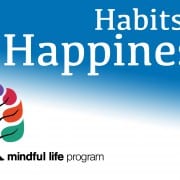The Four Keys to Living Mindfully
If we want to live a meaningful life with attention and intention, developing the freedom to live consciously, we need to start training our busy, distracted mind and be able to make healthy choices that are beneficial to the life we want to live. The four key areas of mindfulness to make this transformation possible; attention, values, wisdom and an open heart.
Attention – The first step is to begin developing our attention by establishing a daily meditation practice. In this way we will start training the mind to attend to what we choose to attend to, instead of having it constantly drag us around. In order to live a meaningful life, we need to be present in our life. This means we have to be able to consciously bring our awareness into the moments of our life, instead of constantly being distracted with thoughts, worries, desires, or lost in some past event or future possibility. One of the best methods to cultivate attention and train the mind is the practice of concentration or shamatha meditation.
Shamatha is often translated as calm abiding, allowing the mind to calmly abide on its object of focus. Our mind is usually in one of two states, excitation or laxity. It is either overly active or dull and tired. Our mind gets distracted and is constantly jumping from one thought to another, or is tired and cannot focus. The practice allows one to bring their mind into balance, not too excited or lax, making it serviceable and productive. The building blocks of this meditation practice are relaxation, stability and vividness. The foundation is relaxation, without it there is no sustained progress. First we relax our body and our mind and then direct our attention to our object of meditation. By continually bringing our attention to our object of meditation, over time we develop stability. Eventually, having cultivated relaxation and stability we increase the vividness and clarity of our meditation practice. All of this takes time and a continuous practice. However you will make progress with every meditation session and see great benefit from simply learning to relax. While there are many forms of shamatha practice, we primarily focus on mindfulness of breath.
Values – Values are a critical component of mindfulness and yet, unfortunately, it is left out of so many programs. The source of finding inner peace, genuine happiness and wellbeing is living a life that is in alignment with one’s values and is of benefit to oneself, others and to the greater good. This is an easily verifiable, universal truth that we have learned our whole life. Lasting happiness does not come from outside sources such as other people, places things and events. It comes from how we live our life and what we bring to the world. When our actions are not in harmony with our values, it is easy to recognize that we don’t feel good about ourselves or others. However, when we live a life of integrity, ethically, in alignment with our values, it is much easier to find inner peace and a lasting sense of well-being. When we are mindful, we are aware of when our thoughts and actions are out of alignment with our values, creating disharmony with ourselves and others. The point of mindfulness is to cultivate healthy habits that are beneficial to yourself and others and in alignment with your values.
Often people think of their mindfulness practice as their time in meditation. While this is in fact practice, the majority of your true practice is how you live your life. All too often there is a disconnect between meditating on loving-kindness in the morning and yelling in anger at someone later in the day. Unless you are one of those rare individuals that has the precious opportunity to devote the majority of your life to meditative practice, most of your day will be spent engaged with others as you participate in daily activities of work, play and family life. The bulk of our mindfulness practice is learning to live in harmony with others and the demands and challenges of our daily life. It is easy to be peaceful and calm on the meditation cushion, but much more challenging to be kind to a neighbor that we don’t like. Our meditation practice provides us with the fuel to take our practice into our daily life. It’s hard to make good choices if were not present in the moment. In order to make a choice we have to be there. Conversely we will find that as we make healthier choices in our life, living ethically and in alignment with our values, we will find more inner peace and this improves our ability to meditate. These practices are interrelated and help each other. The more we progress in our meditation, the better able we are to be present in our life and make healthy choices. As we are more mindful in our daily activities and able to make healthy choices that are beneficial to oneself and others, we develop a sense of well-being and calmness which improves our meditation sessions.
Wisdom – As we begin to increase our attention through meditation, we are now more able to consciously bring awareness into our daily activities. We can start observing ourselves, others and the world more accurately, recognizing unhealthy habits and tendencies, biases, projections and emotional triggers in our lives. With this level of awareness, we recognize the impermanent nature of emotions, thoughts, events, and identify the true sources of our suffering as well as the true sources of our genuine happiness and wellbeing.
We often hear that mindfulness is supposed to be nonjudgmental. The context of that is true in mindfulness meditation where one does not judge any thoughts or emotions that arise during meditation. It also applies to making absolute judgments, prejudging people and events in our lives and judgments based on our biases, projections and labeling of others. However, the whole point of mindfulness is to cultivate wisdom and clear discernment, essentially to have good judgment. “Mindfulness, when it arises, follows the courses of beneficial and unbeneficial tendencies: these tendencies are beneficial, these unbeneficial; these tendencies are helpful.” In fact it’s impossible to live without judgment. We use our judgment constantly to make the choices in our lives. To eat healthy or not, to exercise or not, to return a phone call or not, what to wear each day, and the list goes on.
Every time we make a choice we make a judgment. The key is to be able to make healthy choices that are beneficial to yourself and others with discerning wisdom that is based in reality. Bringing discerning awareness into our daily lives we are able to identify three primary misperceptions – ways our mind causes confusion and create suffering:
Impermanence – We try to make things permanent that are not permanent. We forget that everything is constantly changing and try to preserve things that cannot be preserved. Our relationships, our jobs, our homes, our towns, our bodies, our feelings, our attitudes, our personality, etc. are all impermanent and constantly changing. We create a lot of suffering in our lives when we forget this and try to unrealistically keep things as they are. We make a plan for a day and when things don’t go our way, we get frustrated rather than simply adjust and make a new plan.
Unsatisfactoriness/Happiness – We keep trying to find lasting happiness in things that can only provide a temporary pleasure. There is no person, job, relationship, house, car, vacation, family or activity that can provide any lasting happiness. The most that any person, thing or events can provide us is a temporary pleasure. In fact, when we look at the source of our worry and suffering, it is usually the very things that we thought would bring us happiness. There is absolutely no problem with enjoying our friends, relationships, activities and vacations. We just need to be realistic about what they can and cannot offer us. This is also true of suffering, we can exaggerate even very small troubles in our life, allowing them to dominate our whole day.
Misperception/understanding of self – We tend to have a strong sense of “I” that is independent of others and has a unique set of characteristics, qualities and personality that is the same from day to day. However, when we investigate this we find that we are actually very interdependent. The food we eat, the clothes we wear, the books we read, the ability to read, to drive, to recreate, to communicate, etc. is all dependent upon others, as well as our environment, culture, society and government. The “I” that we grasp onto is also actually very fluid, changing day-to-day. We are not the same person that we were five years ago, ten years ago, or even yesterday. Another way we misperceive our self is by strongly identifying with our feelings. Imagining that “I am sad,” “I am angry,” “I am happy,” etc. You are not your feelings, you experience your feelings. Feelings will come and go and you will still be here. The misperception of our self and our relationship with others, create much suffering, such as jealousy, pride, low self-esteem, fear, resentment, and discontent and prevent us from engaging fully with the world and opening ourselves up to all our potentials. Not only can we change, we do change all the time.
The more we are able to recognize and assimilate these three truths into our own lives accurately, the less we will suffer.
An Open Heart – It is a universal truth that we cannot feel both love and anger at the same time for the same thing. Love can switch to hate in a second and hate to love, but they cannot be simultaneous. It is like turning a light on in a dark room. It is also a universal truth that what we water grows. That is to say the mental states and tendencies that we nurture grow. As the neuroscientists say, “neurons that fire together, wire together.” Or as an old wise Cherokee parable states:
One evening an old Cherokee Indian told his grandson about a battle that goes on inside people. He said, ‘My son, the battle is between two ‘wolves’ inside us all. One is Evil. It is anger, envy, jealousy, sorrow, regret, greed, arrogance, self-pity, guilt, resentment, inferiority, lies, false pride, superiority, and ego. The other is good. It is joy, peace, love, hope, serenity, humility, kindness, benevolence, empathy, generosity, truth, compassion and faith.’ The grandson thought about it for a minute and then asked his grandfather: ‘Which wolf wins?’ The old Cherokee simply replied, ‘The one you feed.’
When we cultivate equanimity, loving-kindness, compassion and empathetic joy in our hearts and minds, we grow the antidotes to attachment and aversion, hatred, ill will and jealousy.
© 2015 Mindful Life Program Inc







